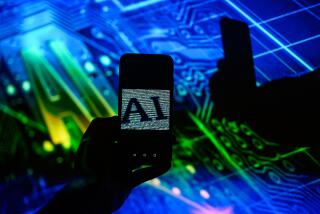Cutting Edge: Developing the robot of the future
- Share via
UC San Diego is establishing a robotics institute aimed at developing machines that can interpret such things as facial expressions and walking styles and size up people’s thoughts, actions and feelings.
The See-Think-Do technology is largely meant to anticipate and fulfill people’s everyday needs, especially for the growing number of older Americans who want to remain in their own homes instead of moving into an assisted-living facility or nursing home.
Engineers also envision creating robots so good at sizing up people, places and situations that they could help evacuate crowds from dangerous areas and pick through the rubble of an earthquake in search of survivors.
The new Contextual Robotics Institute at UC San Diego was unveiled Friday. The university has already lined up support from local companies such as Qualcomm Inc., which needs new markets for its computer chips, and Northrop Grumman Corp., which works on unmanned aircraft.
“Our plan is to do the research and development that are needed to realize robots of the future — robots that are safe, useful and autonomous in any environment,” said Albert Pisano, dean of UC San Diego’s Jacobs School of Engineering.
“That means pulling together our engineers and our social scientists to focus on both the robots themselves and how people will interact with them,” he said.
Robotics is a field seemingly without boundaries.
Google is testing self-driving cars. The Massachusetts Institute of Technology is fashioning bionic arms. The Santa Clara, Calif., company Savioke is experimenting with mechanical butlers that deliver snacks to hotel guests.
The Defense Department is working on “intelligent” machines that can distinguish between enemies and allies. And Canadian researchers are exploring whether it’s possible to design robots that can teach themselves to perform common tasks — such as cooking dinner — by watching YouTube videos.
“The field of robotics is changing how people live, work and age,” said UC San Diego Chancellor Pradeep Khosla, an internationally renowned robotics expert who played a key role in establishing the new institute.
More than 40 of the school’s researchers have volunteered to collaborate on projects aimed at getting hardware and software to recognize their environments and what’s occurring in them. Such robots, or robotic systems, would be programmed to synthesize the information and then take appropriate, useful actions.
Broadly speaking, the robots would be able to see, think and do.
Such research can be humbling, particularly if you’re developing semiautonomous robots that move. That was painfully obvious in June when teams from around the world competed in the DARPA Robotics Challenge in Pomona.
Many of their robots tipped over or did nothing when told to perform a complex task in a challenging environment.
But scientists are making much progress with software, which is often the essence of a robot or robotic system.
For example, UC San Diego has been developing the sort of software and sensors that would be needed to unobtrusively monitor the health and well-being of an elderly or disabled person in their home. The objective: allow people to “age in place” — a place they desire.
The university’s researchers have formulated facial-recognition programs that can detect an array of emotions, including joy, sadness, surprise and disgust. They also have developed software that assesses how much pain a person is feeling.
These advancements have come as researchers nationwide have been developing wireless sensors that can detect things such as whether a person is moving normally and whether he or she is taking the correct prescription medications and opening the refrigerator to get food. Some of the sensors are wearable, while others can be embedded in household appliances, furniture and flooring.
Scientists said it’s possible to blend the software and sensors into systems that size up how a person is doing, then text or email the information to his or her family, caregiver or doctor.
“The thought of going to an assisted-living facility or a nursing home is scary for most people,” Khosla said. “People want to live in their homes as they age, and this is where sensors, software and robotics technology can be most impactful. They enable smarter caregiving and more independence.”
Many challenges lie ahead for researchers pursuing consumer-friendly robotics. Scientists have a spotty record of creating user-friendly technology, especially in robotics. In addition, some people may object to being monitored continually. And technology can be fallible and vulnerable.
“Smart objects connected together was once a great marketing tagline. Now it is becoming an Orwellian nightmare, not just because Google can drive the car while you text. Now we know your car has millions of lines of code in it and is easily hacked by two guys on a couch with a laptop,” Leslie Orlov recently wrote on her widely respected blog, Aging in Place Technology Watch.
Yawen Li, a health sociologist at San Diego State University, said: “The biggest concern I see is privacy. How do you protect data that is collected in a person’s home and sent to a service provider?”
Meanwhile, Qualcomm is spreading its financial and technical support across a wide range of projects — from increasingly sophisticated drone systems to a game console for unattended dogs.
“The field of robotics is in a state of revolution,” said Matt Grob, Qualcomm’s chief technology officer. “And the [UC San Diego] robotics institute intersects with our business in multiple ways. Having this center in our backyard is very exciting. We get to the forefront of what researchers are doing.”
Robbins is a reporter for the San Diego Union-Tribune.
Twitter: @grobbins






